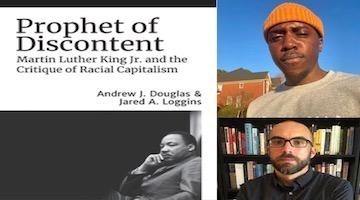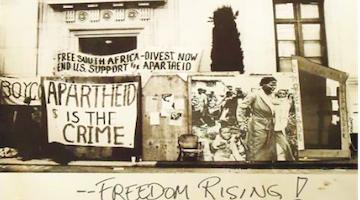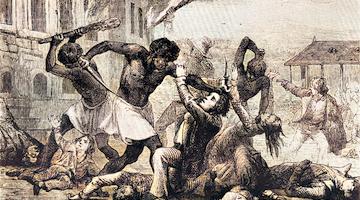“If the Movement for Black Lives can indirectly lead to an expanded sphere of safety for white women of a certain class status, with no commensurate enhanced protection for black people, then this is how blackness is used to meet non-black needs.”
Part I
Bruce Dixon’s two-part essay on intersectionality and afro-pessimism, published on Black Agenda Report on January 27 and February 1 of this year, raised salient issues that warrant further address in this venue. Although I both agree and disagree with Dixon’s take at different points, I respect and share his frustration with various aspects of the black academy, black feminism, and social change—and especially the insidiousness with which identity politics pervades both the dominant and dissenting culture of politics. I offer the following as a modest gesture to extend the discussion, submitted in two parts a la Dixon’s original intervention.
While black feminists point to early foremothers such as Ida B. Wells, Anna Julia Cooper, Claudia Jones, Callie House, and Sojourner Truth (as Dixon notes in his “two intersectionalities” discussion), both black feminism and intersectionality in their contemporary iterations are phenomena of the post-civil rights era. Intersectionality arises from black women’s critique of the manner by which the status quo co-opts challenges against it, and the functionary role played by black elites and black men in particular in this process. Along these lines, black feminists have consistently exposed the gross inadequacies of white feminism and the ongoing realities of sexism, misogyny, homophobia, and sexual violence within black spaces (including activist circles and the academy), and thus how black women’s experiences are forced into an either-or non-choice between being black or being female, queer, or trans. Many black feminists thus continue to lead a necessary confrontation not only with this sex and gender violence, but also as a feature of the very class struggle Dixon calls for—in other words, the kind of intersectionality of which he approves.
“Intersectionality arises from black women’s critique of the manner by which the status quo co-opts challenges against it, and the functionary role played by black elites and black men in particular in this process.”
I do agree with Dixon, however, that intersectionality discourse is a dead-end, and perhaps more to the point, that black feminism itself has revealed its own internal conceptual limits or an institutionalized decadence that should be rethought. Insofar as this is the case, it is not because of black feminists per se, but rather because of the impacted ground for black praxis. Intersectionality, in other words, is no less symptomatic of the state of black power today than is mass incarceration, infant mortality, or the commercialization of hip hop. All discourse has its material conditions, and the concrete realities out of which contemporary black feminism emerged included the repression by terror of a militant blackness that had congealed during the Black Power era but which emanates from longstanding traditions of black self-defense and self-determination, and the blaming of the victims of the state’s counter-insurgency to the tune of black hyper-sexuality (chauvinist brothers, on the one hand, and sisters-out-of-place, on the other hand).[i] Although the political, economic and ideological restructuring of U.S. society between the 1950s and the present has aggravated the manifold crises and contradictions of capitalist democracy, the changes have only ratcheted up the gratuitous violence against black people, in particular coordinated efforts at all levels of state and civil society to detain black community organizing—all the while racial discourse largely devolved around the terms of racial sex and gender pathology crystalized in the notorious Moynihan Report that construed black poverty as a function of an ascribed black family pathos.
“The discourse of lynching in which the mythological black rapist threatens the purity of white femininity, and by extension, the stability of white society, was superseded by a discourse in which the black family posed the primary danger.”
The Moynihan Report signified resistance to desegregation and laid the preemptive groundwork for undermining the nascent Black Power movement. It also stands as a defining lightning rod for post-civil rights black feminism. While the duty to police black self-determination was shifting during the civil rights period from everyday white people in communities across the country, where it had served as the basic glue of modern society throughout the slavocracy and the century of lynching, to a law enforcement apparatus that was becoming newly professionalized and coordinated across local, regional, and national jurisdictions expressly to contain black mass mobilization, the Moynihan Report shows that a repurposing was already underway in the sexual terms of this antiblack violence.[ii] Although lynching has not altogether ceased, the discourse of lynching in which the mythological black rapist threatens the purity of white femininity, and by extension, the stability of white society, was superseded by a discourse in which the black family posed the primary danger, namely its matriarchal structure that was said to engender sexual degeneracy and chaos. In Greg Thomas’ words, these are “the carnal dynamics of white domination” and “the erotic brutality of what is termed race.”[iii]
“Racist warfare became intelligible principally as gender and sex politics.”
Although it is but one illustration of modern society’s antiblackness, the Moynihan Report represents the terms in which the vicious and sadistic attacks on black self-determination in the COINTELPRO period were legitimated and redirected at the same time. Racist warfare became intelligible principally as gender and sex politics, such that by the 1980s black feminist texts began to appear in greater numbers, recording the void in which black women’s issues had been disappeared, swallowed up by sexist assumptions about race and racist assumptions about sex. The war against black people in the present period has been waged in the same manner that it has been since the dawn of the African slave trade in the ninth century Indian Ocean—a panoply of gratuitous violence, from kidnappings to sadomasochistic torture and sexual assault to all manner of exploitation and the criminalization of any expressions of black self-possession; and the language in which this war is represented has also been consistent across the millennium-plus: in terms of a graphic and normative language of sex and gender, the basic codes imputing black savagery and conferring white civilization.
One thing that this historical context means is that intersectionality emerges as the hegemonic language for thinking politically, and black feminism has become what it is, due to the largely successful quarantine of black power in thought and action. If independent black institutions and the vibrant critiques and alternative practices they fostered of not only the meaning of blackness but also of virtually every mode of Western empire—“democracy,” “nation,” “gender,” “sex,” “rights,” “progress,” “family,” “justice,” “work,” “liberty,” and so on—had not been thoroughly stomped, we would have a wider array of viable options for getting free. It is a paradigm problem: at its most fundamental level, the revolutionary era of Black Power challenged the paradigm of a slaveholding society. Even the most important and incisive movements for social change today are largely sequestered within this paradigm, leaving them easily usurped.
“If independent black institutions and the vibrant critiques and alternative practices they fostered had not been thoroughly stomped, we would have a wider array of viable options for getting free.”
One possible illustration of this parasitism (to employ a concept Dixon usefully introduced in his essays) todayis the intersection, if you will, between the Movement for Black Lives and the #MeToo campaign. Given that sexual violence has been going on routinely for a very long time, we might wonder why the accusations against powerful men abusing (mostly white) women are finally being heard now. Although there are many possible factors, I suggest that the M4BL may be an important part of the explanation for why this modicum of accountability for longstanding patterns of misogyny is occurring now. M4BL re-focused the nation’s attention onto the violence of policing, and yet police officers continue their daily assaults unabated. In late September 2017, when a teenager accused two New York Police Department officers of arresting her in Coney Island and raping her while she was in handcuffs, it was only the latest incident of cops raping young girls during the period of M4BL. Even irony is overwhelmed by history: it would be historically consistent if the most immediate outcome of M4BL, initiated in its current historical iteration by three black feminists, were that elite white men are held accountable for their assaults on (mostly) white women. Presumably such white men—even thesewhite men—are also assaulting women and girls of color, but considering Bill Clinton, Dominique Strauss-Kahn, and numerous other powerful white men who are accused of assaulting black women but are never held accountable, it is clear that being white and female is the prerequisite for victimhood. This truth is well-known, but if the M4BL can indirectly lead to an expanded sphere of safety for white women of a certain class status, with no commensurate enhanced protection for black people, then this is how blackness is used to meet non-black needs and an example of how the ethical dilemmas of civil society are parasitic on antiblack sexual violence.
“M4BL re-focused the nation’s attention onto the violence of policing, and yet police officers continue their daily assaults unabated.”
My suggestion that the protocols of black feminism as they have developed in the post-civil rights period are also part of this dynamic where the M4BL can foment vindication for white, not black, victims of violence is a difficult proposition requiring measured scrutiny. Black feminism may be vulnerable in this way to cooptation in the absence of black power, but the persistence of a feminist language of empowerment minus the social context to make it manifest is just as costly. The suppression of black power on a social level means that on the interpersonal level victims of trauma remain victims for life, violators proceed with impunity, and the individual categories of identity stand-in for the social empowerment necessary to heal and make lives whole.
Part 2
I suggested in Part 1 that the sequestration of black power praxis is the condition of possibility for intersectionality and goes some way to explaining why the latter often works at cross-purposes with black freedom. The same analysis goes for “afro-pessimism.” I mean this both in a debilitating and a generative sense: the COINTELPRO era stripped black thought of the programmatic context in which foundational concepts could be rethought and practiced differently (gender, self-determination, law and representation, cultural authority and global solidarity—namely, Pan-Africanism—and so on); but it also exposed the civil rights and multicultural social movement paradigm, and the conceits of the male-leadership model, for the ruses they have proven to be. “Afro-pessimism” emerges out of this post-civil rights period, where black self-determination has been thwarted, in part, precisely through the “advances” in civil rights ostensibly geared towards realizing equality and “justice.”
What does it mean, exactly, to be “afro-pessimist” in the present period? Deborah Bowen states it straightforwardly: “An afro-pessimist is just a black pessimist. It’s a black person who is frustrated with the reality that we have not come as far as we like to think we have.”[iv] Saidiya Hartman is usually credited with coining the term in its present iteration after a reviewer of her book Scenes of Subjection labeled it “pessimistic” because the book shows that emancipation did not ameliorate the condition of enslavement, but instead was the site of its re-elaboration and extension. Hartman explains her “pessimism” thusly:
“But I think there’s a certain integrationist rights agenda that subjects who are variously positioned on the color line can take up. And that project is something I consider obscene: the attempt to make the narrative of defeat into an opportunity for celebration, the desire to look at the ravages and the brutality of the last few centuries, but to still find a way to feel good about ourselves. That’s not my project at all, though I think it’s actually the project of a number of people.[v]”
“’Afro-pessimism’ emerges out of this post-civil rights period, where black self-determination has been thwarted, in part, precisely through the ‘advances’ in civil rights.”
Whereas much of black historiography keeps pointing back to the strides of civil rights, or to this or that act of resistance, the black pessimist acknowledges that the war on black survival continues, unabated and unbroken by Jubilee, formal legal equality, Oprah, you name it. In this sense, then, we might say that “afro-pessimists” abound in black history. David Walker published An Appeal to the Coloured Citizens of the World in 1829, calling for black unity, action, and self-determination informed by deep suspicion regarding the inclinations of the slaveholding class, inclusive of white abolitionists. Walker’s contemporary, Martin R. Delany facilitated John Brown’s preparations for the Harper’s Ferry raid, and whether in his novel Blake or in his 1854 pamphlet The Political Destiny of the Colored Race on the American Continent, Delany left record of a nascent black nationalism, of the intransigence of antiblackness, or of the need for black emigration out of the U.S.—either way, a decidedly sober early analysis of the forces arrayed against black life in the early modern era.
The civil rights period and its aftermath produced no shortage of black pessimism, too. In his 1963 “Message to the Grassroots” speech, Malcolm X told his audience that “integration” meant infiltration of the black revolution, citing how the March on Washington earlier that year was designed to preempt the black grassroots from taking to the streets to shut down government.[vi] The legal scholars who started the Critical Race Theory movement in the 1980s were scorned for asserting the rather pedestrian claim that racism is endemic to U.S. society and for pillorying First Amendment piety for its racist and sexist violence, among other sensible but discomfiting ideas.[vii] Derrick Bell, in particular, recognized that not only were black people still expendable, but that black suffering has been commuted as success. For instance, he recalled that while he was an attorney for the NAACP Legal Defense Fund in the 1950s working on the school desegregation campaign that culminated in Brown v. Board of Education, black parents opposedthe LDF desegregation efforts and instead called for more money for blackschools.
“The black pessimist acknowledges that the war on black survival continues, unabated and unbroken by Jubilee, formal legal equality, Oprah, you name it.”
Decades later, observing the harm wrought by the desegregation era, Bell advocated “racial realism” in which the black struggle would be free to “think and plan within a space of reality, rather than idealism.”[viii] To borrow Frank Wilderson’s words, the “pessimist” moments in black historical struggle, then, are enabling of black life, not disabling, because they refuse to adjust an analysis of the terror encompassing black existence to “some kind of coherent, hopeful solution to things.”[ix] The problem, then, that “afro-pessimism” represents for black movement is greater than the reluctance to give up the presumption of a previous generation’s hard fought gains. It emerges in this post-civil rights era, a time in which anti-racism and antiblackness commingle with each other, precisely because it responds to the longstanding crisis in black intellectual work.
One of the major limitations of “afro-pessimism” today, however, is that the tradition it calls forth clashes with the tradition in which it is rightfully situated. Long before Hartman, the term “afro-pessimism” was originally coined to refer to a body of scholarship, journalism, commentary, and policy prognostications about the continent of Africa post-independence. The main feature of this original “afro-pessimism” is the notion that Africa’s destiny lies in war, violence, disease, corruption, and hopelessness due to the incapacity of Africans to make improvements in the state of health, poverty, development, peace, and governance since the end of the colonial period. The original “afro-pessimism,” then, is merely the post-colonial extension of the nineteenth-century racist tracts on civilization and history created to justify Western empire.[x]
“The old ‘afro-pessimism’ was ‘pessimistic’ about black capacities, while the new ‘afro-pessimism’ is ‘pessimistic’ about non-blackcapacities for change.”
The problem for today’s “afro-pessimism” is that this old “afro-pessimism” is not that old and it certainly is not past; it is very much still with us.[xi] One of the consequences facing black thought today, then, is confusion about the differing levels at which “optimism” and “pessimism” are pitched in the varied debates that “afro-pessimism” old and new yokes together. The new “afro-pessimism” emerges in the “post-racial” multicultural milieu and its ossification in the U.S. academy—in other words, two decades plus onward from the suppression of Black Power and its zenith of self-determination in black thought and struggle. The new “afro-pessimism” scrutinizes the non-black world, its material and knowledge structures, its filiations, and its psychic commitments that drive its investment in the perquisites of antiblackness. In other words, the old “afro-pessimism” was “pessimistic” about black capacities, while the new “afro-pessimism” is “pessimistic” about non-black capacities for change. This is why two positions on either side of a supposedly impassable divide—new “afro-pessimism” and its objectors—are in fact twin inflections of the same reality. Likewise, this is why analysis that explicitly takes aim at the “afro-pessimism” of today, as Dixon does in his essays, potentially stands as a necessary developmental corrective to any “afro-pessimist” account.
Dixon’s assertion, however, that today’s “afro-pessimism” has no class analysis is mistaken. Wilderson’s work in particular deals extensively with the limitations of Marxism for apprehending black existence. This critique of Western radicalism’s class-based account of human struggle has a long tradition in black thought.[xii] What Dixon objects to, then, is that Wilderson has renovated this tradition to explain why it is that class-based struggle is part and parcel of the antiblack paradigm that redefines black existence in non-black terms. This is one reason why Wilderson is always very careful to say that he does not give prescriptions, because the leading language of struggle is colonized by non-black experience, and the new terms of social movement must be created on the ground not in the academy. We can debate the merits of this approach, of course, but Dixon is deigning to engage with the substantive critique on offer.
“The cautionary message about coalition is that it inevitably requires a displacement of black self-determination.”
The same goes for Dixon’s mischaracterization of the “afro-pessimist” critique of coalition politics. Again, today’s “afro-pessimism” has renewed a rich tradition in black thought that has long cautioned against a reliance on multicultural coalition for black freedom, while at the same time pursuing such coalitions strategically. The cautionary message about coalition, however, is that it inevitably requires a displacement of black self-determination. Malcolm X railed invectives against precisely the ‘minority’ logic that Dixon reiterates and that subtends the coalition imperative. Dixon further undermines black thought in his faulty historical arguments for coalition. Slavery did not end when whites jumped on board the abolitionist cause, as Dixon claims; rather, enslaved black people freed themselves, as W. E. B. DuBois explains. This necessary corrective to both white nationalist and Marxist historiography that DuBois provides in Black Reconstruction in America goes a long way to explaining the short life of Reconstruction: it was never the intention of the white nation to end slavery and create a racial democracy in the first place. Or, perhaps more to the point, DuBois opens an altogether different understanding of Reconstruction: not as a failure, per se, but rather that the post-Emancipation nation was rebuilt in the image of its original intention to preserve slaveholding culture, if not as a political economy. Racism and anti-racism can both be white nation-time narratives such that stories about white supremacy may share more in common with abolitionism than may first appear. I suggest that the foregoing interpretation is consistent with today’s “afro-pessimism,” that it is also faithful to the black radical tradition, and that it “centers” black self-determination alongside a sober assessment of the nation’s deep-seated commitment to antiblackness.
Tryon P. Woods teaches Crime & Justice Studies at the University of Massachusetts, Dartmouth and Black Studies at Providence College. He is the co-editor of On Marronage: Ethical Confrontations with Antiblackness (Africa World Press) and Conceptual Aphasia in Black: Displacing Racial Formation (Lexington), co-author of the forthcoming Ex Aqua: The Black Mediterranean and the Excavation of Black Power (Manchester UP), and author of the forthcoming Blackhood Against the Police Power: Punishment and Disavowal in the “Post-Racial” Era (Michigan State UP), from which this essay draws.
Notes
[i] Spillers, “Peter’s Pans,” 7.
[ii] On the development of a national law enforcement apparatus, see Tony Platt et al., The Iron Fist and the Velvet Glove: An Analysis of the U.S. Police(Berkeley: Center for Research on Criminal Justice, 1977).
[iii] Thomas, The Sexual Demon, 1, 2.
[iv] Deborah Bowen, personal communication, November 24, 2017.
[v] Saidiya V. Hartman, with Frank B. Wilderson, III, “The Position of the Unthought,” qui parle13(2) Spring/Summer 2003: 185.
[vi] Malcolm X, “Message to the Grassroots,” in George Breitman, ed., Malcolm X Speaks: Selected Speeches and Statements (New York: Grove, 1965), 14-17.
[vii] See Mari Matsuda, Charles R. Lawrence, III, Richard Delgado, and Kimberle Williams Crenshaw, Words That Wound: Critical Race Theory, Assaultive Speech, and the First Amendment(Boulder: Westview, 1993).
[viii] Derrick Bell, “Racial Realism,” Connecticut Law Review 24(2) Winter 1992: 377. Bell was castigated for his allegory about aliens from outer space that arrive to offer America an end to all of its ills—debt, disease, environmental destruction, crime, poverty, and so on—in exchange for giving up its black citizens to some unknown fate at the hands of the space traders. See, Bell, Faces at the Bottom of the Well: The Permanence of Racism (New York: Basic, 1993).
[ix] Wilderson, “The Position of the Unthought,” 183.
[x] See Cheik Anta Diop, Civilization or Barbarism: An Authentic Anthropology (Chicago: Chicago Review, 1991). On the post-colonial “afro-pessimism,” see Critical Arts25(3) 2011, Special Issue: “The Afropessimism Phenomenon”; Gloria Emeagwali, “Six Types of Afro-Pessimists,” Udadisi, December 24, 2012, https://udadisi.blogspot.com/2012/12/six-types-of-afro-pessimists.html.
[xi] See for example, Toussaint Nothias, “Definition and Scope of Afro-Pessimism: Mapping the Concept and Its Usefulness for Analysing News Media Coverage of Africa,” Leeds African Studies Bulletin 74 (December 2012): 54-62, https://web.archive.org/web/20170905005922/http://lucas.leeds.ac.uk/article/definition-and-scope-of-afro-pessimism-mapping-the-concept-and-its-usefulness-for-analysing-news-media-coverage-of-africa-toussaint-nothias/. Also see the many reports produced over the years by organizations such as the Association of Concerned Africa Scholars and Black Agenda Report itself.
[xii] Including, for starters, each in their own ways: Ella Baker, Oliver Cromwell Cox, W.E.B. DuBois, Hosea Hudson, C.L.R. James, Claudia Jones, Robin D.G. Kelley, Anthony Monteiro, Cedric Robinson, Kwame Ture, Rhonda Y. Williams, Malcolm X, Richard Wright, and many more.



















